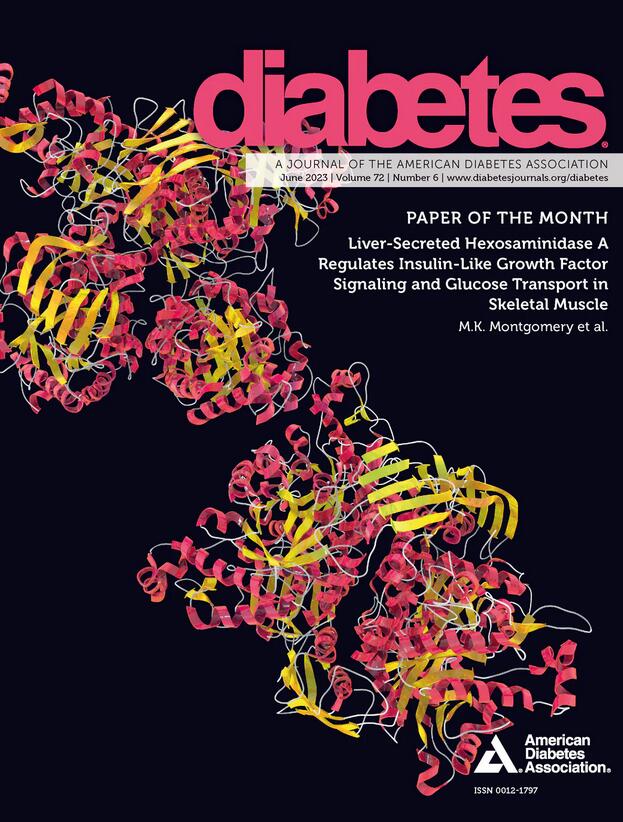Roux-en-Y胃旁路术后伴有和不伴有减肥后低血糖个体的β-细胞质量
IF 7.5
1区 医学
Q1 ENDOCRINOLOGY & METABOLISM
引用次数: 0
摘要
减肥后低血糖(PBH)是Roux-en-Y胃旁路术(RYGB)的严重并发症,其特征是严重的低血糖,可能导致意识丧失和癫痫发作。PBH的确切机制尚不清楚。一种可能的机制是β细胞扩增。为此,我们使用[68Ga] Ga-NODAGA-exendin-4正电子发射断层扫描/计算机断层扫描成像(PET/CT)研究了RYGB后有和无PBH个体的β细胞质量。纳入RYGB后有PBH (n = 10)和无PBH (n = 9)的个体。灌注102.2±6.9 MBq [68Ga] Ga-NODAGA-exendin-4示踪剂后,行PET/CT成像,定量胰腺β细胞质量。两组在性别、年龄、BMI和RYGB后的总体重减轻方面没有差异。有PBH的人与没有PBH的人相比,从RYGB到纳入的时间更长。各组间β细胞质量无显著差异。患有PBH的人的胰腺比没有PBH的人小。β细胞质量与体重参数和代谢参数均不相关。我们的数据表明,在RYGB后,β细胞质量在有和没有PBH的个体之间没有差异,这反驳了β细胞质量扩大来解释PBH的观点。肥胖后低血糖(PBH)的确切机制尚不清楚,但β细胞团扩增被假设发挥了作用。我们使用[68Ga] Ga-NODAGA-exendin-4正电子发射断层扫描/计算机断层扫描(PET/CT)来测定Roux-en-Y胃旁路手术后伴有和不伴有PBH的个体的β细胞质量。β-细胞质量在有和没有PBH的个体之间没有差异。与没有PBH的人相比,有PBH的人的胰腺体积更小。我们的数据不支持β细胞团扩增解释Roux-en-Y胃旁路术后PBH。了解PBH需要进一步的研究。本文章由计算机程序翻译,如有差异,请以英文原文为准。
β-Cell Mass in Individuals With and Without Postbariatric Hypoglycemia After Roux-en-Y Gastric Bypass
Postbariatric hypoglycemia (PBH) is a serious complication of Roux-en-Y gastric bypass (RYGB), characterized by severe hypoglycemia that may lead to loss of consciousness and seizures. The exact mechanism of PBH is poorly understood. One potential mechanism is β-cell expansion. To this end, we investigated β-cell mass in individuals with and without PBH after RYGB using [68Ga]Ga-NODAGA–exendin-4 positron emission tomography/computed tomography imaging (PET/CT). Individuals with PBH (n = 10) and without PBH (n = 9) after RYGB were included. PET/CT imaging was performed after infusion with 102.2 ± 6.9 MBq of the [68Ga]Ga-NODAGA–exendin-4 tracer to quantify pancreatic β-cell mass. The two groups did not differ with respect to sex, age, BMI, and total body weight loss after RYGB. Time between RYGB and inclusion was longer for individuals with PBH compared with those without. β-cell mass did not differ between the groups. Individuals with PBH had a smaller pancreas than those without. β-cell mass correlated neither with body weight parameters nor with metabolic parameters. Our data indicating that β-cell mass does not differ between individuals with and without PBH after RYGB argue against expansion of β-cell mass to explain PBH. ARTICLE HIGHLIGHTS The exact mechanism of postbariatric hypoglycemia (PBH) is unclear, but β-cell mass expansion is hypothesized to play a role. We used [68Ga]Ga-NODAGA–exendin-4 positron emission tomography/computed tomography (PET/CT) to determine β-cell mass in individuals with and without PBH after Roux-en-Y gastric bypass surgery. β-Cell mass did not differ between individuals with and without PBH. Pancreas volume was lower in individuals with PBH compared with those without PBH. Our data argue against β-cell mass expansion to explain PBH after Roux-en-Y gastric bypass. Further study is required to understand PBH.
求助全文
通过发布文献求助,成功后即可免费获取论文全文。
去求助
来源期刊

Diabetes
医学-内分泌学与代谢
CiteScore
12.50
自引率
2.60%
发文量
1968
审稿时长
1 months
期刊介绍:
Diabetes is a scientific journal that publishes original research exploring the physiological and pathophysiological aspects of diabetes mellitus. We encourage submissions of manuscripts pertaining to laboratory, animal, or human research, covering a wide range of topics. Our primary focus is on investigative reports investigating various aspects such as the development and progression of diabetes, along with its associated complications. We also welcome studies delving into normal and pathological pancreatic islet function and intermediary metabolism, as well as exploring the mechanisms of drug and hormone action from a pharmacological perspective. Additionally, we encourage submissions that delve into the biochemical and molecular aspects of both normal and abnormal biological processes.
However, it is important to note that we do not publish studies relating to diabetes education or the application of accepted therapeutic and diagnostic approaches to patients with diabetes mellitus. Our aim is to provide a platform for research that contributes to advancing our understanding of the underlying mechanisms and processes of diabetes.
 求助内容:
求助内容: 应助结果提醒方式:
应助结果提醒方式:


